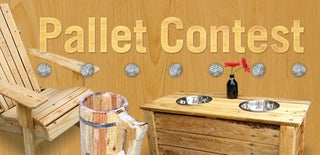Introduction: Woodpecker Door Knocker
With just a few tools and some wood scraps (time to use that old pallet that's sitting behind your garage!), you can make this delightful knocker for your door. I saw this on an old log cabin years ago and made a few for my family and friends. The cool part about this project is that you don't need any advanced skills or large, expensive woodworking equipment.
Here's what you'll need:
- Wood - In the spirit of reuse, I hacked apart an old shipping pallet. I harvested some 1/2" and 3/4" hardwood.
- A spring. About 2" long, not too fat, maybe 1/4" max. You can find these at home improvement stores for cheap.
- A small piece of metal for the bird's nose / striker. 1/4" is good, or whatever you can find. I'm using a wood screw for this 'ible.
- A small piece of metal to use as the strike plate. A coin will do nicely.
- A metal pin to use as a pivot. I'm using a finish nail.
- Some chain - 1/4" or less is best, since it will have to run through a hole drilled in the bird's body
- Small eyescrews (3) - two for the spring, one for the chain
- Some screws
- Some paint and primer. It will be outdoors, so use paint that will hold up well. A weathered look is nice, but peeling paint isn't so appealing. I used the classic black, red and white for my fellow.
A note about this Instructable:
If you own a drill press, band saw or other woodworking equipment, some of the steps shown here will seem pretty primitive. My goal was to make this project accessible to folks who don't have loads of tools or cash, so I'm only showing techniques that use relatively inexpensive tools. If you have fancy tools, you probably don't need me to elaborate on their use anyhow. :-}
Step 1: Sketch Out Your Parts
See the pictures above for the templates I used for my door knockers. I doubt that it remotely represents a woodpecker that actually exists in the real world, but it exists in mine. Invent your own bird, use mine, or sketch one that's ornithologically correct.
** If you are using pallet wood, you should sand to at least 150 grit to smooth it out and remove splinters before transferring any designs onto the wood.
Once you've decided on your design and sketched it out, transfer it to your wood. You can do this a bunch of different ways, one of which is to cut it out, tape it to the wood and trace.
Things to watch out for when designing and laying out your bird:
- The head will need to rotate forward when you pull the chain, so make sure there is clearance. You can fix this later when you do a preliminary assembly.
- Think about the orientation of the wood grain when laying out your design. Wood tends to split along the grain, so drilling holes along the grain may cause you failure problems, now or later. Include hole positions on your sketches to help you with this decision.
- The narrow end of the tail should be as wide as the body thickness so it will fit between the wings.
- The way I've drawn the templates is a little off. The tail will sit too close to the base plate and possibly interfere with the chain. Either make the body a little taller or make the tail a little shorter.
Step 2: Cut and Sand Your Parts
Now that you've gotten the parts transferred to your wood, use your jigsaw or band saw to cut them out. Take your time and try to be as exact as you can - it will save you sanding later. For the wings, you'll need two that are close to identical, so use some double sided tape or a couple of screws to attach two pieces of wood so you can cut both at once.
Once you've gotten them cut, sand off the rough patches. Use a dowel wrapped in sandpaper for the contoured parts to avoid digging into the wood. You can also get some drum sanding attachments for your drill or drill press to make the job quicker.
A few notes:
- I used thicker wood for the body and head of the woodpecker. In order to have clearance for the head to pivot, I sanded the head extra so that it would be 1/16" thinner than the body.
- The base of the tail sits on a notch on the body piece. Make sure it sits nicely and doesn't overlap on the sides as that will interfere with the wings.
Step 3: Drill, Test Assemble, and Drill Some More
Dry assemble your door knocker before drilling holes or screwing anything together permanently. This will ensure you have proper clearances for the moving parts and that nothing is getting stuck.
Drill some holes:
Body:
- Drill a hole through the body for the chain. Make sure it's big enough (I used a 3/8" hole) so the chain has lots of wiggle room, but not so big as to compromise the structure of the bird's body. If you don't have a drill press, clamp the body part to your bench/table and use a hand drill. My electric drill has a bubble level that I kept an eye on while drilling the hole. Start with a smaller (1/4") bit and work up to the size you want. If you try to drill it all in one go, you may split the wood. Take your time with this part.
- Hold off on drilling the pilot hole in the body for the spring. If you do this after the bird is assembled, you'll have a better idea of exact placement.
Head:
- Drill a hole (carefully!) in the nose for the striker. The nose is pretty narrow, so go gently.
- Drill 2 pilot holes in the head part for the eyescrews. One will be for the chain, the other for the spring. See pictures.
Test assemble:
Put your bird together and see how everything fits. You'll probably need to do some more sanding and shaping so things will work smoothly.
Drill more holes:
Wings:
- With one wing sitting on the body, drill two holes through the wing and through the body.
- Drill one hole through the wing and through the lower part of the head. This will be for the pivot.
- Remove the wing and transfer the holes to the other wing, so they will line up properly when assembled.
- Countersink the holes on the outside of each wing (just the 2 that attach the wings to the body, not the one for the head.
Head:
You'll need to enlarge the hole you just drilled (the one from the wings through the head. The hole in the head needs to be bigger than the ones on the wings, since this will be the pivot point for the head.
Tail:
Drill and countersink a pilot hole to attach the tail to the body.
Watch out for:
The tail. The tail is angled pretty sharply down towards the base plate. Make sure your tail is not so long that it will interfere with the chain or with mounting the body onto the base plate.
Step 4: Paint, Put It Together, Mount, and Admire
Once you're satisfied with the fit, take it apart again and paint it. Since this will be living outdoors, use a quality primer and then a paint that will do well outdoors. The birds look nice when weathered, but they look pretty awful if your paint starts peeling. If you're unsure, ask the folks at your local paint store or home improvement place.
When the paint is dried, you can move on to final assembly.
Suggested assembly order:
- Attach the tail.
- Screw the wings onto the body. The pilot holes go all the way through, but I use shorter screws and screw on each wing individually.
- Attach the striker to the bird's nose. You may wish to dab some epoxy in there to keep weather out.
- Attach the eyescrew and spring to the back of the head.
- Attach the chain to the eyescrew on the front of the bird's neck and thread it down through the hole in the body.
- Use a finish nail or other metal rod to mount the head. The nail should bite into the wings, but the head should be able to move freely. You'll need to enlarge the hole in the head if you haven't already done so. Use some epoxy to secure the nail to the wings if you need to, but be careful not to get any on the head.
- Position the spring so that the head is pulled back a bit, then drill a pilot hole on the bird's back for the eyescrew.
Mount:
Now select a mounting plate for your door knocker. Might I suggest a piece of pallet? Perhaps unpainted so it will weather to a rustic gray? I used an 18" base plate, which works well with the size of my woodpecker.
Set your assembled woodpecker in the middle (both horizontally and vertically) of your base plate and trace a rectangle around where the body meets the base. Holding the woodpecker in that same spot, pull on the chain and note where the striker hits the base plate. If you put a little chalk or pencil scribble on the bird's nose, it will transfer over to the base plate.
For the strike plate, nail or glue piece of metal (a coin works well) onto the base plate at the location where the bird's nose hit.
Drill two pilot holes through the base plate in the rectangle you traced earlier. Now flip the base plate over and countersink the holes. Then drive the screws through the back of the base plate so they are sticking out of the front just a little bit. Press the woodpecker back onto the rectangle. This will put little dents in the bird's body that you'll use for drilling pilot holes. Drill those pilot holes in the body. Now you can screw those screws all the way through the base plate and into the body of your woodpecker.
You're done! Now you can mount the woodpecker outside your door and be the envy of the neighborhood.
Notes:
I used a couple of pan head screws for the eyes. You can also paint them on. If you decide to glue on googly eyes, please don't tell me.
If you find glaring mistakes or omissions, please be nice when you point them out.
If you like this Instructable, feel free to vote for it in one of the contests I've entered.

Participated in the
Summer #mikehacks Contest

Participated in the
Outdoor Workshop Contest

Participated in the
Great Outdoors Contest

Participated in the
Epilog Challenge VI

Participated in the
Pallet Contest













